The OnePlus 2 Review
by Brandon Chester on December 14, 2015 8:00 AM EST- Posted in
- Smartphones
- Mobile
- OnePlus
- OnePlus 2
GPU Performance
While general performance on the OnePlus 2 ends up being quite disappointing, when focusing on GPU performance we can hope for a much more appealing outcome as Adreno 430 continues to be one of the best GPUs you can get in a mobile device. While I don't expect there to be a large deviation from the performance of other Snapdragon 810 devices, given the unexpected difference with JavaScript and general CPU performance it's worth running the OnePlus 2 through our standard GPU benchmarks to confirm that everything is performing as expected. As always, we start off with 3DMark, followed by BaseMark X and GFXBench.
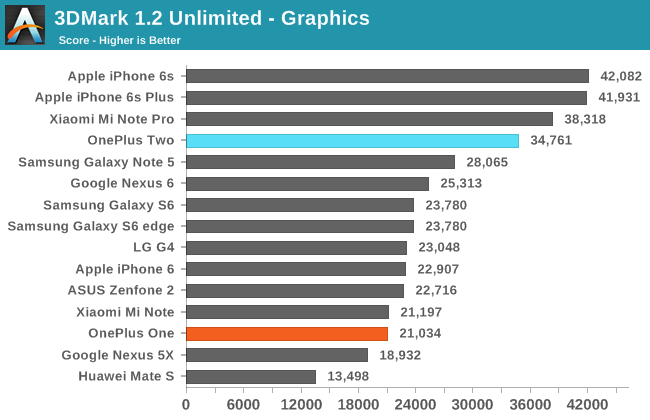

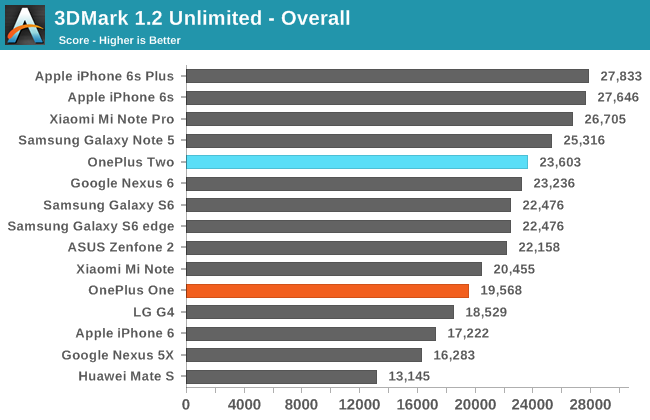
Snapdragon 810's Adreno 430 GPU is still very fast, and it achieves a very high score in 3DMark's graphics test. As usual, the physics test score basically just scales with frequency and number of cores in use, and with the big cores on the SoC throttling down we see a fairly low result there. I don't usually care much for the overall score, but since it's a weighted average we see the OnePlus 2 sitting near the Nexus 6, although in workloads that mainly stress the GPU you'll actually see a much larger gap between the two.
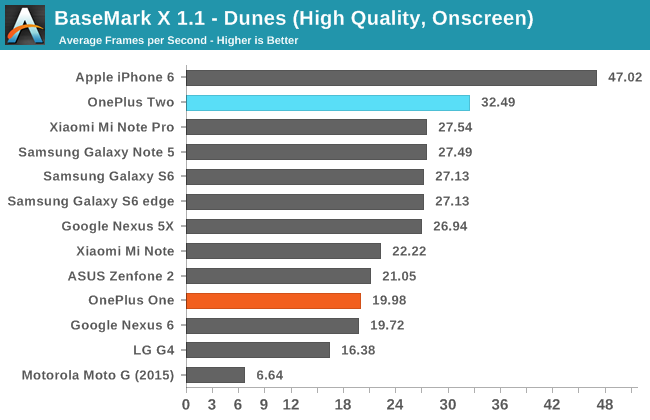
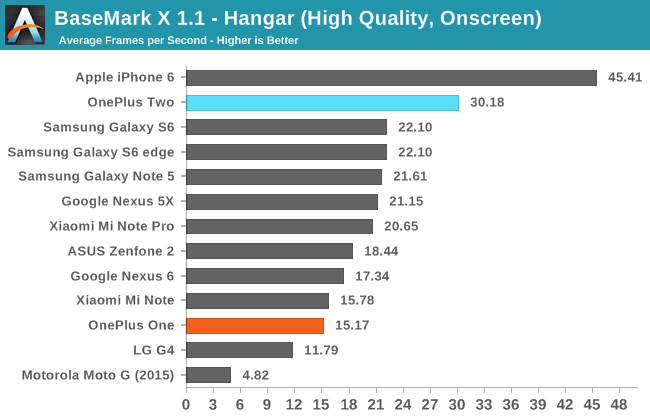
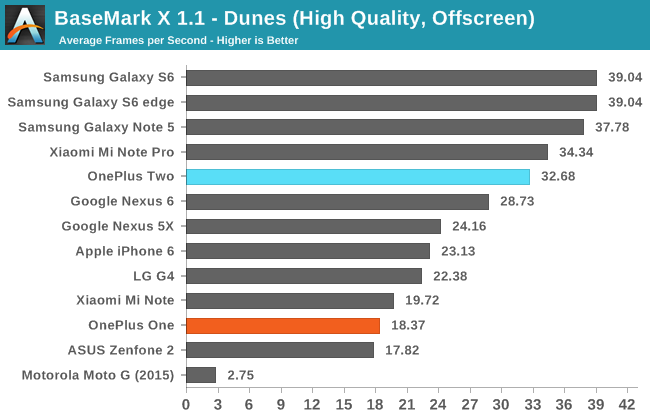
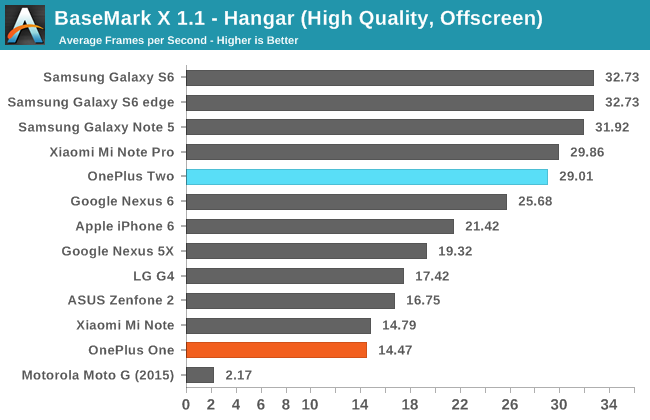
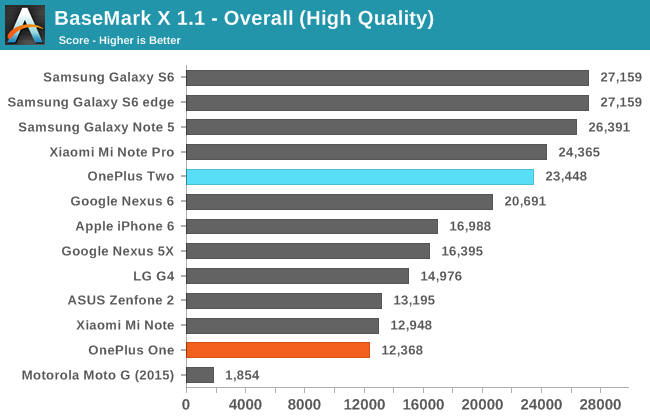
The OnePlus 2 performs very well in BaseMark X, tracking slightly behind the Mi Note Pro which we previously noted may have some level of additional optimizations at the driver level compared to the other Snapdragon 810 implementations. The improvement over the OnePlus One with its Adreno 330 GPU is quite large, with there being nearly a doubling in performance in the Hangar benchmark.

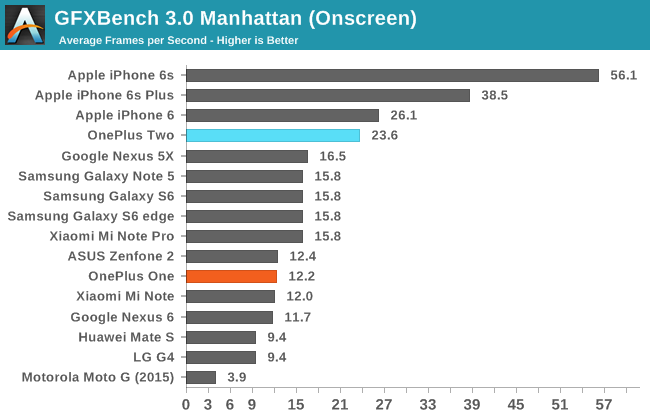

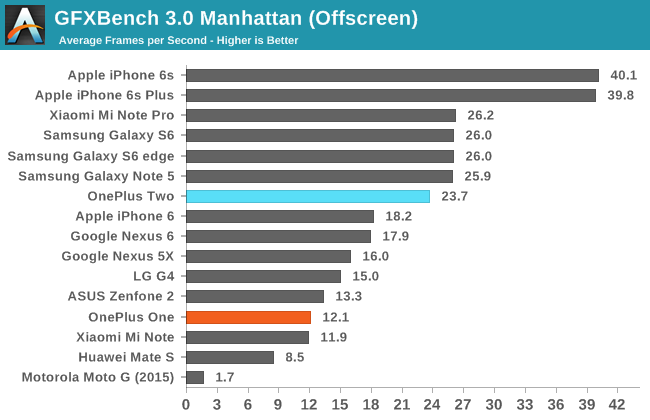
GFXBench's off screen performance results show that the OnePlus 2 is again a bit slower than the Mi Note Pro. In any case the performance is still very good and only really beaten by Samsung's Exynos 7420 devices, and the iPhone 6s. Since the display resolution is only 1080p you actually get better performance in games that run at native resolution than the Mi Note Pro and Galaxy Note5.
Adreno 430 has always been a good GPU, and in general the GPU performance of Snapdragon 808 and 810 hasn't really suffered in the same way the CPU performance has. At $400 the OnePlus 2 definitely gives you a lot of GPU power, and it's something that differentiates it from what's available at lower prices, and even other devices at the same price like the Nexus 5X.
NAND Performance
NAND performance is becoming a greater focus in mobile devices. To improve performance, vendors like Samsung and Apple have turned to solutions outside of the eMMC storage that is typically used in mobile devices. However, the vast majority of products still use eMMC NAND, and in some cases the performance of that NAND can be low enough to introduce noticeable performance issues when using a device. The OnePlus Two uses a Samsung CGND3R eMMC 5.0 NAND solution, which is the same as the one used in the Mi Note Pro.

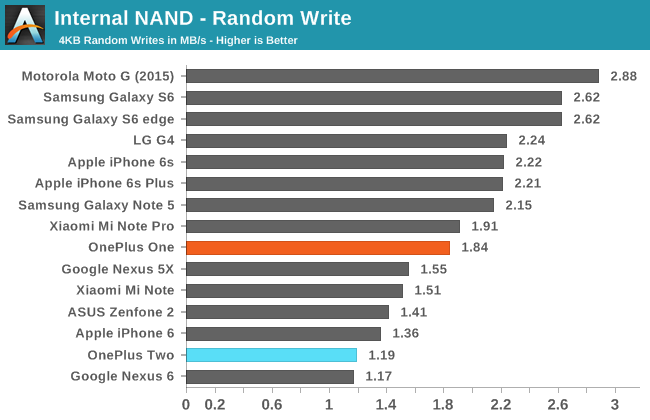
Random read speeds track closely with the Mi Note Pro. Random writes end up being quite a bit slower, and this occurs even with repeated tests so I'm not sure exactly what's causing it.
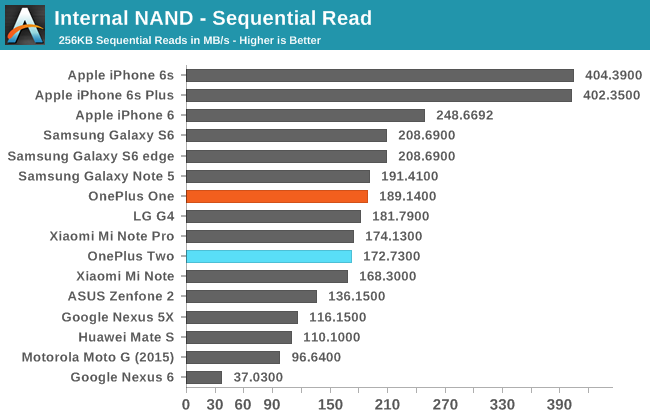
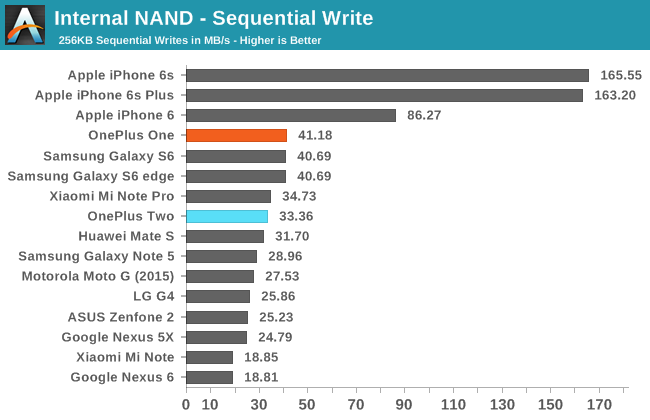
As expected, sequential read and write speeds track almost exactly with the Mi Note Pro. While the results are nothing ground-breaking, they're in line with what you get from an eMMC 5.0 NAND solution. In most cases another component of the phone will likely end up limiting performance before one runs into issues due to NAND speeds, but you won't see some of the benefits that you get with extremely fast NAND such as extremely quick app installation times, faster media transfers, etc.










132 Comments
View All Comments
aenews - Tuesday, December 15, 2015 - link
The author mentions his dislike of the "back cover material" many times throughout the article and fails to see the point of a removable back plate. He clearly does not realize StyleSwap™ exists and is a major selling point of the phone.He also doesn't seem to realize there's a color slider in settings that adjusts the tint of the screen. Pulling the slider all the way to the right would yield more color-accurate displays for most OnePlus 2's. He should have tested further with the spectrophotometer IMO. Everyone has his own temperature preferences in regards to the display.
Brandon Chester - Thursday, December 17, 2015 - link
I'm not sure how you can assert that the slider would have an impact without having measured a difference. I did do that, and the difference is insignificant. It's just not a good display.Also, no company offering heavy phone customization is doing very well financially in the smartphone market, so something like StyleSwap is clearly not a major selling point for most consumers.
MarcSP - Tuesday, December 15, 2015 - link
Random Android device: ReviewFlagship of the third mobile platform: Nope!
MarcSP - Tuesday, December 15, 2015 - link
That's really weird. In any case, you could have explained that from the begining.Still, thanks for the reply :-). And ignore another message I posted later. I thought the first one had failed.
vishnumrao - Tuesday, December 15, 2015 - link
Well written and informative review.This review is giving me a sever bout of "buyer's remorse". I was deliberating with myself, between the Nexus 6P and the OnePlus Two. I jumped the gun, when I got an invite. I bought it based on the "on paper" specs and the rave reviews of the predecessor.
Right off, I felt the UI sluggish. Ever so slightly! Some hesitation to move! I installed Cpu Spy app and I started noticing that the processors were maxed out at 1555 (1.56 GHz on the A53). Even when playing games, I never saw CPU states higher than that.
I was surprised by the color accuracy assessments. I never noticed it. Maybe I am not very color sensitive.
The hope is that CM 13 will officially support OnePlus Two phones. That should fix some of the issues on the CPU usage. Oxygen OS is buggy too! An example of a bug I found: https://forums.oneplus.net/threads/cpu-usage-durin...
No official acknowledgement of the issue and no fix either.
I wish I had never got that invite to buy!
SydneyBlue120d - Tuesday, December 15, 2015 - link
Still no HEVC encoding from the Snapdragon 810, do You know if there is some hack to shot videos in HEVC? Thanks a lot.dexterkarthik - Tuesday, December 15, 2015 - link
finally - this review helped in ruling out OP2 and wait for the SD820 to come and then zero in on the Nexus 6P is on sale!!vladx - Tuesday, December 15, 2015 - link
Wtf are you putting S808 in the same sentence with S810? S808 does very well, as shown by the LG G4 score in the tests. Even beats S6 in some.Lbhati - Tuesday, December 15, 2015 - link
@Brandon oneplus one never had ois. Please correct that.albireox - Wednesday, December 16, 2015 - link
Is the reviewer actually aware that the much highlighted Oneplus One display had a yellow tint on a great number of batches sold by Oneplus? So is then relevant that the OnePlus One had better calibrated screen ?On the other hand, you seem to miss that Oneplus 2 has dual SIM functionality that isn't present in a lot of phones that you regard (and recommend) as better purchases?